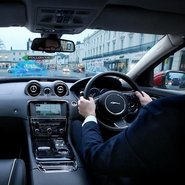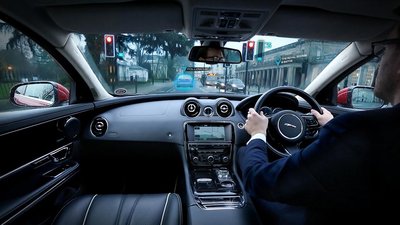 Jaguar's Follow-MeGhost Car Navigation
Jaguar's Follow-MeGhost Car Navigation
British automaker Jaguar Land Rover is working to eliminate drivers’ blind spots through the introduction of its 360 Virtual Urban Windscreen technology.
The automaker’s latest technology concept is still in the research phase, but is set to change how drivers operate their vehicles and reduce collisions. Automakers commonly tout the driving experience through experiential initiatives, but recently there has been a rise in technological advancements such as automation and digital windshield displays meant to elevate daily interactions with an automobile.
“We want to provide the driver with the right information at the right time, without distracting them, so they can make the best decisions in the most demanding and congested driving environments,” said Nick O’Donnell global corporate public relations manager, Jaguar Land Rover, Northampton, Britain.
“Drivers take their eyes off the road as they drive across town when they are looking at road signs, or when trying to locate a parking space as they drive by, for example,” he said. “So if we can display fuel station prices, landmarks and parking spaces on the HUD in the driver’s eye-line, the driver won't have to seek it out for themselves and take their eyes off the road ahead.
“We are also looking at innovative new navigation systems to both enhance the urban driving experience and make it safer. The most intuitive and efficient way to navigate to a specific location is to be able to follow someone who knows the best route - hence Follow-MeGhost Car Navigation. In terms of road safety, again the driver won't have to look for road signs for example, and take their eyes off the road.”
On the future road
To introduce the 360 Virtual Urban Windscreen to consumers, Jaguar shared a video on its social media accounts. In the just over 2-minute video, Jaguar highlights the capabilities of its 360 Virtual Urban Windscreen concept beginning with the roof support pillars.
In the video, the consumer is shown how the roof pillars become transparent to give the driver a 360 degree view of the vehicle’s surroundings. Jaguar’s technology would be embedded into the surface of the roof pillars, inside the vehicle, and will display a live video feed from cameras positioned to cover blind spots created by the A, B, and C-pillars supporting the roof.
 Jaguar insibile pillars on the 360 Virtual Urban Windscreen
As other vehicles, cyclists and pedestrians come into view of the cameras, the pillars inside the vehicle will become transparent using Jaguar’s Heads-Up display. Drivers will have the option to highlight the aforementioned obstructions highlighted in an on-screen halo as they move across the vehicle’s virtual windscreen.
The technology will be reactive as well, responding to drivers’ turns and updating accordingly with the movement of the vehicle. For example, when the vehicle turns a corner, the pillars on the right or left side, given the direction of the turn, will become transparent.
After this concept is explored, the video continues to show off the “Follow-MeGhost Car Navigation” effort currently being developed by Jaguar. Follow-MeGhost Car Navigation was inspired by the idea that following someone who knows the route is the best way to drive to an unfamiliar location.
Jaguar insibile pillars on the 360 Virtual Urban Windscreen
As other vehicles, cyclists and pedestrians come into view of the cameras, the pillars inside the vehicle will become transparent using Jaguar’s Heads-Up display. Drivers will have the option to highlight the aforementioned obstructions highlighted in an on-screen halo as they move across the vehicle’s virtual windscreen.
The technology will be reactive as well, responding to drivers’ turns and updating accordingly with the movement of the vehicle. For example, when the vehicle turns a corner, the pillars on the right or left side, given the direction of the turn, will become transparent.
After this concept is explored, the video continues to show off the “Follow-MeGhost Car Navigation” effort currently being developed by Jaguar. Follow-MeGhost Car Navigation was inspired by the idea that following someone who knows the route is the best way to drive to an unfamiliar location.
 Jaguar's Follow-MeGhost Car Navigation
For this, Jaguar created a projection of another vehicle that will appear on the 360 Virtual Urban Windscreen. The driver will just simply follow the projection in front of them, turn by turn, until arriving at their desired destination.
The 360 Virtual Urban Windscreen’s full functionality would be made possibly by a Cloud connection. When the vehicle is connected to a roadside infrastructure or businesses in the area, the Virtual Urban Windscreen could tell the driver relevant information such as the price of gas or open parking spaces to avoid distractions.
Also, the driver would not have to rely on simply the names of roads to follow directions, but rather the Virtual Urban Windscreen can plot routes based on visible landmarks such as restaurants and stores.
Jaguar Land Rover introduces the 360 Virtual Urban Windscreen
In the tech seat
Safety is a main factor in Jaguar’s research of the 360 Virtual Urban Windscreen.
“Some of the ways that this concept would improve road safety are as follows: Roof pillars have gradually increased in thickness to reflect more stringent safety legislation, which can create blind spots for drivers,” Mr. O’Donnell said. “We have already launched some technologies such as Blind Spot Monitoring to alleviate this and we are developing research projects like 360 Urban Windscreen to move this forward a significant step.
“This project would take a live video feed from cameras covering the angles outside the car usually obscured in the blind spots created by the A, B and C-pillars so the driver would have an uninterrupted 360 degree view around the car,” he said. “By combining the transparent pillars with an advanced high quality Heads-Up display, the movement of other road users could be highlighted to the driver with an on-screen halo across the car’s virtual windscreen. This concept will also help to reduce driver distraction and help keep theirs eyes on the road.”
Automakers have been researching technologies that have the potential to alter the driver experience as consumers know it today.
For instance, German automaker Audi created a commercial to celebrate Halloween and draw attention to the brand’s night vision technology.
The video demonstrated the clarity of the night vision and the importance of the technology on a night like Halloween. With a fun and informative commercial, Audi was likely to spark the interest of many consumers (see story).
Other technological advancements are more simple. For example, German automaker Mercedes released the Maybach S 600 almost simultaneously at Auto Guangzhou in China and the Los Angeles Auto Show.
The new vehicle features the magic sky control panoramic roof with SPD-SmartGlass, a technology that is being offered for the first time with a sliding and stationary roof (see story).
To stay competitive and relevant, brands must be transparent about research and development projects to maintain consumer interest.
“Both drivers and their passengers are increasingly tech-savvy - in particular driven by smartphones,” Mr. O’Donnell said. “Drivers want technology that will enhance their driving experience and both drivers and passengers with a high-specification smartphone look to us to provide them with a car that can meet and exceed their expectations for staying connected.
“The automotive industry is very competitive and technology features to help ur products stand out,” he said. “We need to deliver these in a way that doesn't distract the driver.
“From a technical point of view it could be ready within five to 10 years as a fully functional system and we are working with suppliers to identify and develop the display technology to help make this a reality. We haven't shared this with any consumers yet. We will be sharing this with different consumer groups worldwide to see what they think of the idea. This will help us develop the project going forward.”
Final Take
Jen King, lead reporter on Luxury Daily, New York
Jaguar's Follow-MeGhost Car Navigation
For this, Jaguar created a projection of another vehicle that will appear on the 360 Virtual Urban Windscreen. The driver will just simply follow the projection in front of them, turn by turn, until arriving at their desired destination.
The 360 Virtual Urban Windscreen’s full functionality would be made possibly by a Cloud connection. When the vehicle is connected to a roadside infrastructure or businesses in the area, the Virtual Urban Windscreen could tell the driver relevant information such as the price of gas or open parking spaces to avoid distractions.
Also, the driver would not have to rely on simply the names of roads to follow directions, but rather the Virtual Urban Windscreen can plot routes based on visible landmarks such as restaurants and stores.
Jaguar Land Rover introduces the 360 Virtual Urban Windscreen
In the tech seat
Safety is a main factor in Jaguar’s research of the 360 Virtual Urban Windscreen.
“Some of the ways that this concept would improve road safety are as follows: Roof pillars have gradually increased in thickness to reflect more stringent safety legislation, which can create blind spots for drivers,” Mr. O’Donnell said. “We have already launched some technologies such as Blind Spot Monitoring to alleviate this and we are developing research projects like 360 Urban Windscreen to move this forward a significant step.
“This project would take a live video feed from cameras covering the angles outside the car usually obscured in the blind spots created by the A, B and C-pillars so the driver would have an uninterrupted 360 degree view around the car,” he said. “By combining the transparent pillars with an advanced high quality Heads-Up display, the movement of other road users could be highlighted to the driver with an on-screen halo across the car’s virtual windscreen. This concept will also help to reduce driver distraction and help keep theirs eyes on the road.”
Automakers have been researching technologies that have the potential to alter the driver experience as consumers know it today.
For instance, German automaker Audi created a commercial to celebrate Halloween and draw attention to the brand’s night vision technology.
The video demonstrated the clarity of the night vision and the importance of the technology on a night like Halloween. With a fun and informative commercial, Audi was likely to spark the interest of many consumers (see story).
Other technological advancements are more simple. For example, German automaker Mercedes released the Maybach S 600 almost simultaneously at Auto Guangzhou in China and the Los Angeles Auto Show.
The new vehicle features the magic sky control panoramic roof with SPD-SmartGlass, a technology that is being offered for the first time with a sliding and stationary roof (see story).
To stay competitive and relevant, brands must be transparent about research and development projects to maintain consumer interest.
“Both drivers and their passengers are increasingly tech-savvy - in particular driven by smartphones,” Mr. O’Donnell said. “Drivers want technology that will enhance their driving experience and both drivers and passengers with a high-specification smartphone look to us to provide them with a car that can meet and exceed their expectations for staying connected.
“The automotive industry is very competitive and technology features to help ur products stand out,” he said. “We need to deliver these in a way that doesn't distract the driver.
“From a technical point of view it could be ready within five to 10 years as a fully functional system and we are working with suppliers to identify and develop the display technology to help make this a reality. We haven't shared this with any consumers yet. We will be sharing this with different consumer groups worldwide to see what they think of the idea. This will help us develop the project going forward.”
Final Take
Jen King, lead reporter on Luxury Daily, New York
